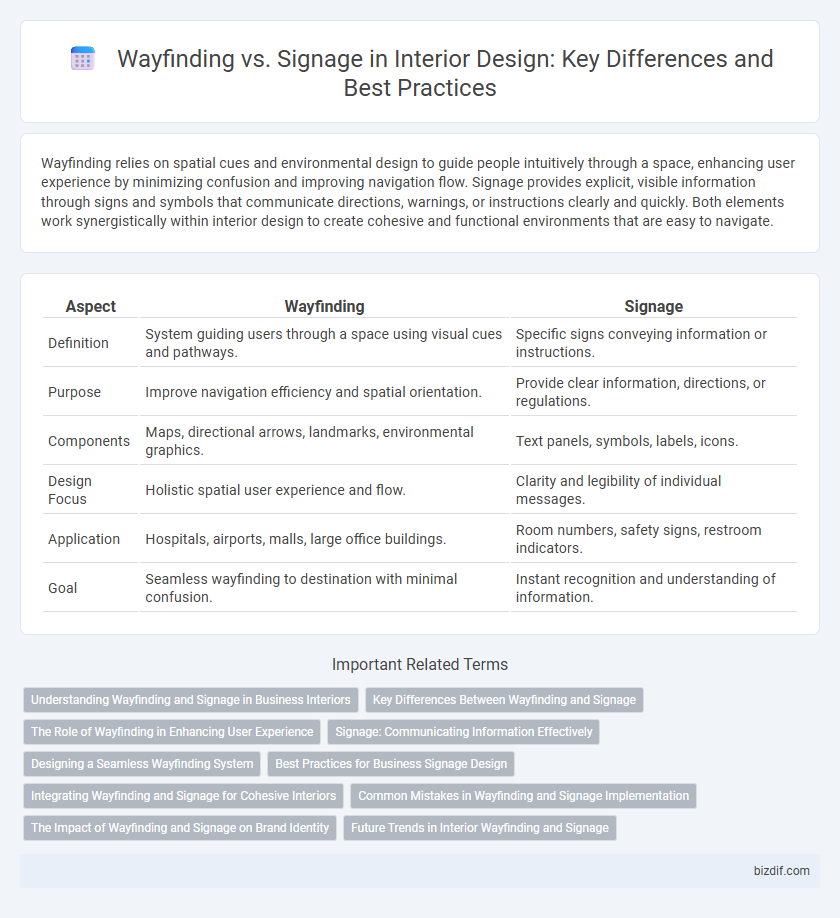Wayfinding relies on spatial cues and environmental design to guide people intuitively through a space, enhancing user experience by minimizing confusion and improving navigation flow. Signage provides explicit, visible information through signs and symbols that communicate directions, warnings, or instructions clearly and quickly. Both elements work synergistically within interior design to create cohesive and functional environments that are easy to navigate.
Table of Comparison
| Aspect | Wayfinding | Signage |
|---|---|---|
| Definition | System guiding users through a space using visual cues and pathways. | Specific signs conveying information or instructions. |
| Purpose | Improve navigation efficiency and spatial orientation. | Provide clear information, directions, or regulations. |
| Components | Maps, directional arrows, landmarks, environmental graphics. | Text panels, symbols, labels, icons. |
| Design Focus | Holistic spatial user experience and flow. | Clarity and legibility of individual messages. |
| Application | Hospitals, airports, malls, large office buildings. | Room numbers, safety signs, restroom indicators. |
| Goal | Seamless wayfinding to destination with minimal confusion. | Instant recognition and understanding of information. |
Understanding Wayfinding and Signage in Business Interiors
Wayfinding in business interiors refers to the strategic design of spatial navigation systems that help users easily orient themselves and locate destinations within complex environments. Signage comprises the visual graphics, symbols, and text specifically designed to convey information and direct movement effectively. Integrating wayfinding concepts with clear, consistent signage enhances customer experience, reduces confusion, and optimizes workflow in commercial spaces.
Key Differences Between Wayfinding and Signage
Wayfinding involves strategic design elements that guide people through physical spaces by utilizing landmarks, pathways, and spatial cues, creating an intuitive navigation experience. Signage refers to the specific visual graphics, symbols, and text installed within environments to provide direct instructions or information. Key differences lie in wayfinding's holistic approach to navigation and the role of signage as discrete informational tools supporting that journey.
The Role of Wayfinding in Enhancing User Experience
Wayfinding plays a crucial role in interior design by guiding users seamlessly through spaces, reducing confusion and stress. Effective wayfinding integrates intuitive visual cues, such as color-coded paths and clear landmarks, enhancing spatial orientation and user confidence. Unlike static signage, wayfinding creates a dynamic and engaging environment that improves navigation and overall satisfaction within complex buildings.
Signage: Communicating Information Effectively
Signage plays a crucial role in interior design by providing clear, concise information that guides visitors seamlessly through spaces. Effective signage incorporates visual hierarchy, legible typography, and strategic placement to enhance user experience and ensure safety. By combining aesthetic appeal with functionality, signage communicates essential directions, warnings, and branding messages efficiently within any environment.
Designing a Seamless Wayfinding System
Designing a seamless wayfinding system integrates intuitive layout, clear visual cues, and consistent signage to enhance user navigation within interior spaces. Effective wayfinding combines directional signs, icons, and maps strategically placed to reduce confusion and improve spatial awareness. Prioritizing user experience through cohesive design elements ensures smooth movement and accessibility in complex environments like hospitals, airports, and office buildings.
Best Practices for Business Signage Design
Effective business signage design hinges on clear wayfinding strategies that guide customers seamlessly through spaces, reducing confusion and enhancing user experience. Employing consistent typography, intuitive icons, and strategic placement ensures that signage not only attracts attention but also communicates information efficiently. Prioritizing accessibility and visibility, especially in varying lighting conditions, supports a professional and welcoming environment crucial for customer retention and brand identity.
Integrating Wayfinding and Signage for Cohesive Interiors
Integrating wayfinding and signage enhances interior design by creating intuitive navigation that complements the overall aesthetic. Strategic placement of cohesive signage elements improves user experience, reduces confusion, and supports brand identity. Harmonizing visual cues and directional information transforms spaces into seamless, engaging environments.
Common Mistakes in Wayfinding and Signage Implementation
Common mistakes in wayfinding and signage implementation include unclear visual hierarchy, inconsistent design elements, and lack of strategic placement, which can confuse users and reduce navigational efficiency. Poorly designed wayfinding systems often suffer from insufficient contrast, overly complex language, and failure to consider diverse user needs such as accessibility and multilingual support. Effective interior design requires integrating clear, intuitive signage that aligns with spatial layout to enhance user experience and streamline movement within a space.
The Impact of Wayfinding and Signage on Brand Identity
Wayfinding and signage play a crucial role in reinforcing brand identity by creating cohesive visual cues that guide users while reflecting the brand's aesthetics and values. Effective wayfinding systems enhance user experience by reducing confusion and fostering intuitive navigation, which strengthens customer perception and loyalty. Consistent and well-designed signage not only directs but also communicates the brand's personality, making spaces memorable and aligned with the overall interior design strategy.
Future Trends in Interior Wayfinding and Signage
Future trends in interior wayfinding and signage emphasize the integration of digital technology such as interactive kiosks, augmented reality, and real-time navigation apps to enhance user experience in complex spaces like airports and hospitals. Sustainable materials and eco-friendly design principles are increasingly prioritized to align with environmental goals, while customizable and adaptive signage powered by AI enables dynamic information updates tailored to individual needs. The convergence of smart building systems with intuitive wayfinding solutions is expected to improve accessibility and operational efficiency in commercial and public interiors.
Wayfinding vs Signage Infographic

 bizdif.com
bizdif.com